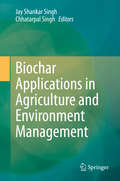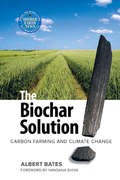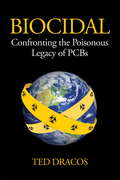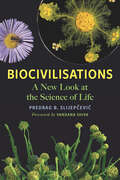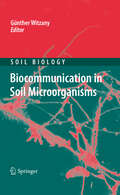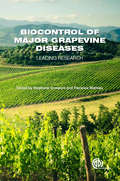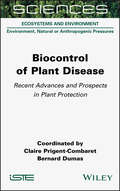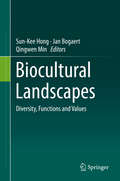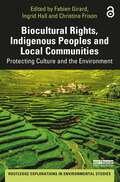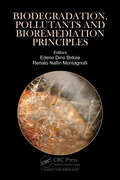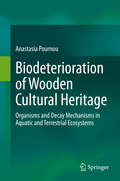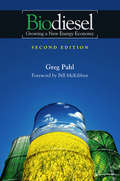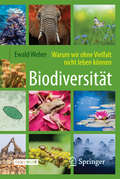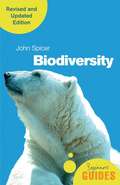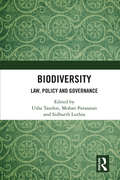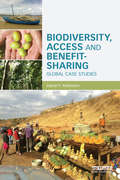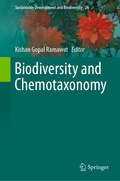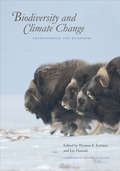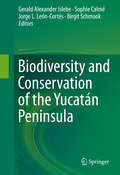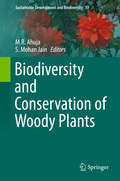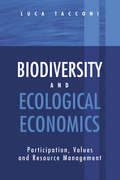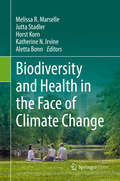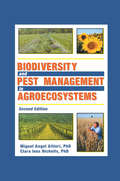- Table View
- List View
Biochar
by Bruckman Viktor J. Varol Esin Apaydın Uzun Başak B. Jay LiuClimate change poses a fundamental threat to humanity, and thus solutions for both mitigation and adaptation strategies are becoming increasingly necessary. Biochar can offer a range of environmental services, such as reclamation of degraded land, improvement of soil fertility and carbon sequestration. However, it also raises questions, regarding sustainable feedstock provision, biomass pyrolysis, and soil amendment. These questions, among various others, are addressed in this state-of-the-art compendium. Covering a broad geographical range, with regional assessments from North America, Europe, the Near East, and Southeast Asia, this interdisciplinary volume focuses on the entire biochar supply chain, from the availability and economics of biomass resources, to pyrolysis, and ultimately to the impacts on soil properties. The combination of theory with practical examples makes this a valuable book for researchers, policymakers, and graduate students alike, in fields such as soil science, sustainable development, climate change mitigation, biomass and bioenergy, forestry, and environmental engineering.
Biochar Applications in Agriculture and Environment Management
by Jay Shankar Singh Chhatarpal SinghThis book provides up-to-date information on biochar use in management of soil health, agriculture productivity, green-house gases, restoration ecology and environment. Biochar application to nutrient deficient and disturbed soils is a viable option which may promotes advances in food safety and food security to human nutrition and overall fundamental research in the agricultural sciences. The book describes in detail how the recalcitrant biochar is able to persist for long periods of time and work as a shelter for soil microbial colonisation and their biomass/numbers. This book also includes contents related to important role of biochar applications in the restoration of contaminated agricultural soils. The book will be of particular interest to students, teachers and researchers in the disciplines.
The Biochar Solution
by Albert BatesConventional agriculture destroys our soils, pollutes our water, and is a major contributor to climate change. What if our agricultural practices could stabilize, or even reverse these trends?The Biochar Solution explores the dual function of biochar as a carbon-negative energy source and a potent soil-builder. Created by burning biomass in the absence of oxygen, this material has the unique ability to hold carbon back from the atmosphere while simultaneously enhancing soil fertility. Albert Bates traces the evolution of this extraordinary substance, from the ancient black soils of the Amazon to its reappearance as a modern carbon sequestration strategy.Combining practical techniques for the production and use of biochar with an overview of the development and future of carbon farming, The Biochar Solution describes how a new agricultural revolution can reduce net greenhouse gas emissions to below zero while increasing world food reserves and creating energy from biomass wastes. Biochar and carbon farming can:*Reduce fossil fuels inputs into our food system*Bring new life to desert landscapes*Filter and purify drinking water*Help build carbon-negative homes, communities, and nationsBiochar is not without dangers if unregulated, and it is not a panacea, but if it fulfills its promise of taking us back from the brink of irreversible climate change, it may well be the most important discovery in human history.
Biocidal
by Ted DracosIn 1962, Rachel Carson stunned the world with the publication of Silent Spring, exposing the lethal character of the pesticide DDT. Her work launched a global campaign against synthetic chemical toxins and veritably created a world environmental movement. But unbeknownst to Carson, an even more insidious chemical cousin to DDT had been silently poisoning the biosphere. Polychlorinated biphenyls (PCBs) were first manufactured in 1920. Seen as a “magic fluid,” they were a cheap and stable heat-transfer material used as a critical coolant in big power grids. The chemical industry soon went on to develop hundreds of other uses for this highly toxic group of substances—everything from copy paper and paint to hydraulic fluids. Despite being outlawed in the U.S. since 1976, PCBs are currently found in the remotest corners of Earth and remain the most prevalent group of industrial chemical contaminants in much of the world. Every human being, from the womb to the grave, bears a body burden of these poisonous molecules forever locked in their blood and tissues. In Biocidal, investigative journalist Ted Dracos tells the full story of PCBs for the first time, starting with the chilling chronicle of how the chemical industry manipulated regulatory agencies and scientific findings for decades to continue to reap huge profits, despite their knowledge of the threats posed by their “magic fluid.” Dracos draws on extensive research to document the connection between PCBs and catastrophic human illness, presenting the latest science as studies draw ever more disturbing links between PCBs and continued health impacts ranging from cancer and autism to immunosuppression and reproductive abnormalities. Biocidal also explores the science behind the threat PCBs pose to Earth’s biodiversity: today, killer whales in the Puget Sound are dying, the eggs of Ontario Lake trout are doomed before they can hatch, 99 percent of the freshwater eels of Europe have disappeared, and frogs around the world are going extinct. While these disasters have many possible causes, evidence pointing to PCBs keeps accumulating, much like the toxins in these animals’ systems. Nonetheless, Dracos leaves readers with a profound message of hope: the damage is not irreversible. In fact, cleanup efforts that involve the removal of the source of PCBs can really work, and quickly. Offering a simple blueprint for steps that can be taken to reduce the impacts of all industrial chemicals, Biocidal ultimately points the way toward a detoxified world.
Biocivilisations: A New Look at the Science of Life
by Predrag B. Slijepčević"A brilliant book [that] shows a way out of the destructive trap of Anthropocentric arrogance."—Vandana Shiva, author of Terra Viva "An unusually thought-provoking and ambitious book."—Dr. James A. Shapiro, author of Evolution: A View from the 21st Century Biocivilisations is an important, original rethinking of the mystery of life and its deep uncertainty, exploring the complex civilisations that existed on Earth long before humans. What is life? Many scientists believe life can be reduced to ‘mechanistic’ factors, such as genes and information codes. Yet there is a growing army of scientists, philosophers and artists who reject this view. The gene metaphor is not only too simplistic but deeply misleading. If there is a way to reduce life to a single principle, that principle must acknowledge the creativity of life, turning genetic determinism on its head. The term biocivilisations is the acknowledgement of this uncertainty of life, as opposed to a quasi-certainty of the human position governed by a narrow time window of the scientific revolution. Life existed without humans for more than 99.99 percent of the Earth’s existence. Life will also continue without humans long after our inevitable extinction. In Biocivilisations, Dr Predrag Slijepčević shows how bacteria, amoebas, plants, insects, birds, whales, elephants and countless other species not only preceded human beings but demonstrate elements of how we celebrate human civilisation – complex communication, agriculture, science, art, medicine and more. Humans must try to adopt this wisdom from other biocivilisations that have long preceded our own. By rethinking the current scientific paradigm, Dr Slijepčević makes clear that a transformation – from a naïve young species into a more mature species in tune with its surroundings – will save us from our own violence and the violence we inflict on the rest of our living planet. "Read this book if you would like to understand the intelligence of living systems."—Dr Denis Noble, University of Oxford
Biocommunication in Soil Microorganisms (Soil Biology #23)
by Günther WitzanyCommunication is defined as an interaction between at least two living agents which share a repertoire of signs. These are combined according to syntactic, semantic and context-dependent, pragmatic rules in order to coordinate behavior. This volume deals with the important roles of soil bacteria in parasitic and symbiotic interactions with viruses, plants, animals and fungi. Starting with a general overview of the key levels of communication between bacteria, further reviews examine the various aspects of intracellular as well as intercellular biocommunication between soil microorganisms. This includes the various levels of biocommunication between phages and bacteria, between soil algae and bacteria, and between bacteria, fungi and plants in the rhizosphere, the role of plasmids and transposons, horizontal gene transfer, quorum sensing and quorum quenching, bacterial-host cohabitation, phage-mediated genetic exchange and soil viral ecology.
Biocontrol of Major Grapevine Diseases: Leading Research
by Stéphane Compant Florence MathieuThis book provides a thorough research update on the very topical subject of biological control of grapevine diseases. It covers fungi, oomycete, bacteria and phytoplasma, and is particularly relevant to organic viticulture but also beneficial as part of IPM strategies for traditional production.
Biocontrol of Major Grapevine Diseases: Leading Research
by Florence Mathieu Stéphane CompantBiocontrol of major grapevine diseases provides a timely research update on the use of biological control agents and plant resistance inducers against phytopathogenic infections of the grapevine by fungi, oomycetes, bacteria and phytoplasma.Taking a holistic approach, this book presents in detail the ecology, mechanisms and the application methods of these agents. Its 19 chapters, authored by international experts, cover diseases such as grey mould, trunk diseases, powdery and downy mildews, as well as phytoplasma diseases, and, by nature, emphasise applications of biocontrol in organic viticulture and as part of integrated pest management systems.
Biocontrol of Plant Disease: Recent Advances and Prospects in Plant Protection
by Claire Prigent-Combaret Bernard DumasFaced with climate changes, pest pressure on plants is increasing and new pest complexes are appearing, for which plant protection solutions are not yet available. The reduction of anthropic pressure on agroecosystems requires a reduction in the use of chemical inputs and the promotion of biocontrol approaches. <p><p> In this book, we present new advances on plant disease management that are emerging from research outputs. The ability of biocontrol products to directly (e.g. production of antimicrobial peptides or quorum quenching activities by microorganisms, use of plant or agro-industrial by-products as biopesticides, etc.) or indirectly (e.g. via the increase of plant defense or plant growth pathways) protect plants against pathogens and pests is also considered. <p><p> We also address new strategies like the development of phage-based biocontrol products and those that consider the plant as a holobiont and plant microbiota as targets of biocontrol treatments. The important question of the current regulatory process needed to launch plant production products on the market is also addressed, such as methods to evaluate their environmental impact.
Biocultural Landscapes: Diversity, Functions and Values
by Sun-Kee Hong Jan Bogaert Qingwen MinThis book is devoted to the cultural and biological dimensions and values of landscapes, linking the concepts of biodiversity, landscape and culture and presenting an essential approach for landscape analysis, interpretation and sustainable dynamics. Early chapters explore the concepts and values of biocultural landscapes, before addressing the methodology to identify the relationship between biological and cultural diversity. The volume continuous with a series of case studies and with an exploration of the key role of biocultural diversity in contemporary landscape ecology. Readers will learn the importance of landscapes for different fields of natural and human sciences and are confronted to the trans-disciplinary nature of the landscape concept itself. A hierarchical approach to landscapes, in which they are composed of interacting (eco)systems, is shown to be essential in recognizing their emergent properties. In this work, the biocultural values of landscapes are explored through their diversity in geographical scopes, methodological approaches and conceptual assumptions. Authors from Asia, Europe and North-America present diverse research experiences and views on biocultural landscapes, their pattern, conservation and management. Landscape ecologists will find this work particularly appealing, as well as anyone with an interest in sustainable landscape development, nature conservation or cultural heritage management. This volume is the outcome of a symposium on "Biodiversity in Cultural Landscapes", organized in the framework of the 8th IALE World Congress, held in Beijing in 2011.
Biocultural Rights, Indigenous Peoples and Local Communities: Protecting Culture and the Environment (Routledge Explorations in Environmental Studies)
by Fabien GirardThis volume presents a comprehensive overview of biocultural rights, examining how we can promote the role of indigenous peoples and local communities as environmental stewards and how we can ensure that their ways of life are protected. With Biocultural Community Protocols (BCPs) or Community Protocols (CPs) being increasingly seen as a powerful way of tackling this immense challenge, this book investigates these new instruments and considers the lessons that can be learnt about the situation of indigenous peoples and local communities. It opens with theoretical insights which provide the reader with foundational concepts such as biocultural diversity, biocultural rights and community rule-making. In Part Two, the book moves on to community protocols within the Access Benefit Sharing (ABS) context, while taking a glimpse into the nature and role of community protocols beyond issues of access to genetic resources and traditional knowledge. A thorough review of specific cases drawn from field-based research around the world is presented in this part. Comprehensive chapters also explore the negotiation process and raise stimulating questions about the role of international brokers and organizations and the way they can use BCPs/CPs as disciplinary tools for national and regional planning or to serve powerful institutional interests. Finally, the third part of the book considers whether BCPs/CPs, notably through their emphasis on "stewardship of nature" and "tradition", can be seen as problematic arrangements that constrain indigenous peoples within the Western imagination, without any hope of them reconstructing their identities according to their own visions, or whether they can be seen as political tools and representational strategies used by indigenous peoples in their struggle for greater rights to their land, territories and resources, and for more political space. This volume will be of great interest to students and scholars of environmental law, indigenous peoples, biodiversity conservation and environmental anthropology. It will also be of great use to professionals and policymakers involved in environmental management and the protection of indigenous rights. The Open Access version of this book, available at www.taylorfrancis.com, has been made available under a Creative Commons Attribution-Non Commercial-No Derivatives 4.0 license
Biodegradation, Pollutants and Bioremediation Principles
by Ederio Dino BidoiaThis book presents a broad compendium of biodegradation research and discussions on the most up-to-date bioremediation strategies. The most relevant microbiological, biochemical and genetic concepts are presented alongside the fundamentals of bioremediation. The topics include: a wide variety of contaminant impacts evaluation, key methodologies required to measure biodegradation and propose new bioremediation protocols, as well as the handling of microbial communities related to such processes. The selected collaborating authors are renowned for their microbiology expertise and will provide an in-depth reference for students and specialists. The contents provide a valuable source of information for researchers, professionals, and policy makers alike.
Biodeterioration of Wooden Cultural Heritage: Organisms and Decay Mechanisms in Aquatic and Terrestrial Ecosystems
by Anastasia PournouSince prehistoric times and throughout the course of human evolution, wood has been an integral part of all civilizations. Wooden Cultural Heritage can be found worldwide, providing valuable information on the social and economic context of human history. Nonetheless, as a natural cellulosic material, wood shows low resistance to biodeterioration and thus wooden Cultural Heritage often fails to escape decomposition in both aquatic and terrestrial ecosystems. This book provides a comprehensive overview on the biodeterioration of wooden Cultural Heritage and describes the decay mechanisms of key organisms and microorganisms encountered in aquatic and terrestrial ecosystems. Cultural Heritage professionals, researchers and academics may explore within this book the associations between deteriogens, habitats and decay, which will assist them to understand wood biodeterioration and design effective prevention, mitigation and remediation strategies. The book presents case studies around the world to demonstrate the impact of biogenic deterioration on wooden Cultural Heritage and illustrates mechanisms and patterns in order to be a useful handbook of decay diagnosis.Lastly, by adopting a holistic approach to wood decay, basic concepts of wood technology, ecology, and deteriogens' biology are introduced, permitting readers of different scientific backgrounds to easily comprehend wood biodeterioration.
Biodiesel
by Greg PahlFor anyone who is trying to keep up with the extremely rapid developments in the biodiesel industry, the second edition of Biodiesel: Growing a New Energy Economy is an invaluable aid. The breathtaking speed with which biodiesel has gained acceptance in the marketplace in the past few years has been exceeded only by the proliferation of biodiesel production facilities around the United States-and the world-only to confront new social and environmental challenges and criticisms. The international survey of the biodiesel industry has been expanded from 40 to more than 80 countries, reflecting the spectacular growth of the industry around the world. This section also tracks the dramatic shifts in the fortunes of the industry that have taken place in some of these nations. The detailed chapters that cover the industry in the United States have also been substantially rewritten to keep abreast of its many new developments and explosive domestic growth. An expanded section on small-scale, local biodiesel production has been added to better represent this small but growing part of the industry. Another new section has been added to more fully explore the increasingly controversial issues of deforestation and food versus fuel, as well as GMO crops. The second edition concludes with updated views on where the industry is headed in the years to come from some of its key players.
Biodiversität - Warum wir ohne Vielfalt nicht leben können
by Ewald WeberEine Einladung in die Biologie der Vielfalt Dieses Buch berichtet über ein ebenso spannendes wie aktuelles Thema an der Schnittstelle zwischen naturwissenschaftlicher Grundlagenforschung und globaler gesellschaftlicher Herausforderung: die Biodiversität. Drei Ebenen kommen hier zusammen: die Vielfalt der Arten in einem Lebensraum, die Vielfalt der Ökosysteme und Lebensräume selbst und die Vielfalt der Gene in den Lebewesen. Der Autor, Biologe und selbst in der Biodiversitätsforschung tätig, nimmt Sie mit auf eine aufregende Entdeckungsreise durch diese mannigfach vernetzte Welt. In leicht verständlicher Sprache und mit vielen anschaulichen Beispielen erklärt er Zusammenhänge und Hintergründe. Wie ist Biodiversität eigentlich definiert, und mit welchen Techniken wird sie erfasst? Wie ist die immense Artenvielfalt auf der Erde entstanden, und wie entwickelt sie sich weiter? Welchen Nutzen hat die Biodiversität auf den verschiedenen Ebenen? In welchem Maße ist die Vielfalt der Arten und Lebensräume heute bedroht, und wie kann man diesem Trend entgegenwirken? Solche und ähnliche Fragen beantwortet dieses Buch, in dessen breitem Themenbogen sich die Vielfalt seines Gegenstands wiederspiegelt. Tauchen Sie ein in die faszinierende Welt der Biodiversität! Der AutorEwald Weber ist Biologe und Sachbuchautor. Er lehrt und forscht an der Universität Potsdam mit Schwerpunkt Biodiversität. Sein Anliegen als Autor ist das Vermitteln von wissenschaftlichen Zusammenhängen und von Naturgeschichte im weitesten Sinn.
Biodiversity: A Beginner's Guide (revised and updated edition) (Beginner's Guides)
by John SpicerOur future is closely tied to that of the variety of life on Earth, and yet there is no greater threat to it than us. From population explosions and habitat destruction to climate change and mass extinctions, John Spicer explores the causes and consequences of our biodiversity crisis. In this revised and updated edition, he examines how grave the situation has become over the past decade and outlines what we must do now to protect and preserve not just nature&’s wonders but the essential services that biodiversity provides for us, seemingly for nothing.
Biodiversity: Law, Policy and Governance
by Usha Tandon Mohan Parasaran Sidharth LuthraConservation of biodiversity is a fundamental concern towards securing a sustainable future. This volume argues that despite various domestic and international policies and legal frameworks on biodiversity conservation — be it forest, wildlife, marine, coastal, etc. — their implementation suffers from many deficiencies. It explores the factors that hinder effective implementation of these policies and frameworks. It also analyses existing laws, both international and domestic, to identify inherent problems in the existing legal system. The book maintains that careful adherence to established procedures and protocols, public awareness, filling the lacuna in legal framework, and a strong political will are sine qua non for effective conservation of biodiversity and sustainable development. The volume defends the protection of traditional knowledge and participation of indigenous communities along with reinforcements of intellectual property in this regard. It also commends the role played by the Indian judiciary, especially the Supreme Court of India and India’s National Green Tribunal for the preservation and enhancement of natural resources by applying established as also evolving principles of environmental law. This book will be useful to scholars and researchers of environmental studies, development studies, policy studies and law related to biodiversity and conservation.
Biodiversity, Access and Benefit-Sharing: Global Case Studies
by Daniel F. RobinsonThe Nagoya Protocol to the Convention on Biological Diversity (CBD) is rapidly receiving signatures and ratifications. Many countries are preparing to implement the protocol through national research permit systems and/or biodiversity laws. Yet there is still considerable confusion about how to implement the Protocol, regarding access and benefit-sharing (ABS) procedures, and minimal experience in many countries. This book seeks to remedy this gap in understanding by analysing a number of ABS case studies in light of the Nagoya Protocol. The case studies are wide-ranging, with examples of plants for medicinal, cosmetic, biotech and food products from or for development in Australia, North Africa, Madagascar, Switzerland, Thailand, USA and Oceania. These will encourage countries to develop national systems which maximise their benefits (both monetary and non-monetary) towards conservation and support for local communities that hold traditional knowledge. In addition, the author analyses new expectations raised by the Nagoya Protocol, such as the encouragement of the development of community protocols by indigenous and local communities. As a result, stakeholders and policy-makers will be able to learn the steps involved in establishing ABS agreements, issues that arise between stakeholders, and the types of benefits that might be realistic.
Biodiversity and Chemotaxonomy (Sustainable Development and Biodiversity #24)
by Kishan Gopal RamawatPlant classifications are based on morphological characters and it is difficult, particularly in small plants and grasses, to identify these below generic level on the basis of these characters using a dissecting microscope. Plant species have intra- and inter-specific variation in secondary metabolites which can be utilized as marker compounds for identification and classification of plants. Secondary metabolites are produced as a result of primary metabolism and the production of these compounds not only involves several genes but also it is an energy dependent process. Hence these products cannot be considered as insignificant for the plant and the environment. Modern tools of molecular biology and secondary metabolites present in them can definitively decide about classification of plants. Absence of correct identification of plant is associated to many problems of resource utilization. Due to wide availability of these tools, interest has revived in systematics and correct classification of plants based on these parameters for their sustainable utilization and resource management. The purpose of this book is to assess the potential of phytochemical and molecular tools in the systematic and classification of plants. The topics covered include species concept, barcoding and phylogenetic analysis, chemotaxonomy use of polyketides, carotenes, cuticular wax, volatile oils, biodiversity of corals, metazoans, Ruta and Echinocereus. It provides comprehensive and broad subject-based reviews, useful for students, teachers, researchers, and all others interested in the field. The field has been kept wide and general to accommodate the wide-ranging topics. This book will be useful to agriculturists, chemists, botanists, industrialists, and those involved in planning of crop plants.
Biodiversity and Climate Change: Transforming the Biosphere
by Thomas E. Lovejoy Lee Hannah Edward O. WilsonAn essential, up-to-date look at the critical interactions between biological diversity and climate change that will serve as an immediate call to action The physical and biological impacts of climate change are dramatic and broad‑ranging. People who care about the planet and manage natural resources urgently need a synthesis of our rapidly growing understanding of these issues. In this all‑new sequel to the 2005 volume Climate Change and Biodiversity, leading experts in the field summarize observed changes, assess what the future holds, and offer suggested responses. From extinction risk to ocean acidification, from the future of the Amazon to changes in ecosystem services, and from geoengineering to the power of ecosystem restoration, this book captures the sweep of climate change transformation of the biosphere.
Biodiversity and Conservation of the Yucatán Peninsula
by Gerald Alexander Islebe Sophie Calmé Jorge L. León-Cortés Birgit SchmookThis book provides information relevant for the conservation of biodiversity and the sound management of the coastal and forest ecosystems of the Yucatan Peninsula in the face of global change. Various aspects of the biodiversity of the Yucatan Peninsula are analyzed in an integrative manner, including phenological, ecophysiological, ecological and conservation aspects of plants and animals and their relationships with humans in coastal and forest ecosystems.
Biodiversity and Conservation of Woody Plants (Sustainable Development and Biodiversity #17)
by M. R. Ahuja S. Mohan JainThis book provides complete, comprehensive, and broad subject-based reviews for students, teachers, researchers, policymakers, conservationists, and NGOs interested in the biodiversity and conservation of woody plants. Forests cover approximately 31 percent of the world's total landmass; 93 percent is natural forest and only 7 percent consists of planted trees. Forest decline is progressing at an alarming rate worldwide. In addition to human activities (logging, deforestation, and exploiting forest lands for agriculture and industrial use), a number of other factors - including pests and diseases, drought, soil acidity, radiation, and ozone - are cumulatively contributing to global forest decline. The present situation forces us to focus on forest conservation strategies for the present and future. Gene conservation and maintaining genetic diversity in forest ecosystems are crucial to the preservation of forest genetic resources. This calls for integrated action to implement both the in situ (on site) preservation of forest stands and ex situ (distant from the original site) strategies for the conservation of woody plants' genetic resources. Selected priority areas include: 1) assessing patterns of genetic diversity and threats, 2) understanding the biological processes regulating genetic diversity, 3) assessing the impact of human activities and climate change on genetic diversity, and 5) finding methods for prioritizing species and populations for the conservation of forest trees genetic resources. All chapters were written by leading scientists in their respective fields, which include: woody plant diversity, ecology and evolution; assessment of genetic diversity in forest tree populations; conservation planning under climate change; and in situ and ex situ strategies, including biotechnological approaches, for the conservation of woody plants genetic resources.
Biodiversity and Ecological Economics: Participatory Approaches to Resource Management
by Luca TacconiIt is vital that we adopt interdisciplinary approaches such as ecological economics to gain an understanding of the values that determine human interaction with, and use and abuse of, the environment. This book is a model of applied ecological economics. It presents an accessible introduction to the subject while at the same time broadening its theoretical basis by introducing a post-positivist, participatory method. The theoretical framework is applied to case studies in biodiversity conservation, drawn from around the world and a range of different ecosystems. The book is a suitable textbook for students of ecological economics and an ideal introduction for scientists and environmentalists needing to understand the role of economics in ecology and conservation.
Biodiversity and Health in the Face of Climate Change
by Aletta Bonn Horst Korn Jutta Stadler Melissa R. Marselle Katherine N. IrvineThis open access book identifies and discusses biodiversity’s contribution to physical, mental and spiritual health and wellbeing. Furthermore, the book identifies the implications of this relationship for nature conservation, public health, landscape architecture and urban planning – and considers the opportunities of nature-based solutions for climate change adaptation. This transdisciplinary book will attract a wide audience interested in biodiversity, ecology, resource management, public health, psychology, urban planning, and landscape architecture. The emphasis is on multiple human health benefits from biodiversity - in particular with respect to the increasing challenge of climate change. This makes the book unique to other books that focus either on biodiversity and physical health or natural environments and mental wellbeing. The book is written as a definitive ‘go-to’ book for those who are new to the field of biodiversity and health.
Biodiversity and Pest Management in Agroecosystems
by Miguel Altieri Clara NichollsExplore the latest research on biological control! Completely updated for 2004, this new edition examines methods for making agricultural systems less susceptible to insect pests. Containing new findings and reports of strategies, Biodiversity and Pest Management in Agroecosystems, Second Edition will show you how pests can be managed by enhancing beneficial biodiversity using agroecological diversification methods. Biodiversity and Pest Management in Agroecosystems, Second Edition provides you with an essential overview of the role of biodiversity in agriculture and then gets specific, with new and updated information on: the agroecology of pest management plant diversity and pest outbreaks within agroecosystems diversification strategies for pest management how sustainable farming systems are designed You'll also explore: the role of plant diversity on the biology of beneficial insects insect regulation in diverse agroecosystems manipulation of plant diversity in agroecosystems ecological and socioeconomic implications The fact is, many modern agroecosystems are unstable as a consequence of constant human intervention in crop systems which ignore ecological principles. With case studies on a variety of crops and pests, Biodiversity and Pest Management in Agroecosystems, Second Edition explores entomological aspects of agriculture and analyzes the ecological basis for the maintenance of biodiversity. It will familiarize you with the theory and practice of enhancing biological pest control in agricultural systems by managing vegetational diversity via multiple cropping, cover cropping, rotations, and other spatial and temporal designs. With studies on intercropping, cover cropping, weed management, and crop-field border vegetation manipulation, this book covers the effects of these diverse systems on pest population density and the mechanisms underlying pest reduction in polycultures. Make it a part of your reference/teaching collection today!

